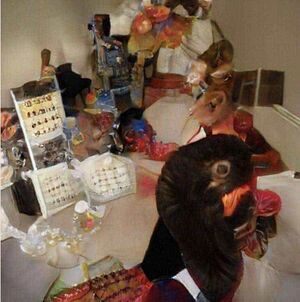Pattern recognition suppression: Difference between revisions
>Graham m Reorganization of categories in edit layout |
>Tracer Experience reports |
||
| (35 intermediate revisions by 5 users not shown) | |||
| Line 1: | Line 1: | ||
<onlyinclude> | <onlyinclude> | ||
'''Pattern recognition suppression''' | [[File:Pattern recognition suppression.jpg|thumb|A simulation of visual distortions accompanying a stroke. Every thing in the picture feels familiar, but cannot be easily named or defined. Substance-driven pattern recognition suppression might feel similar.]] | ||
'''Pattern recognition suppression''' is defined as a partial to complete inability to mentally process and interpret visual information regardless of its clarity. For example, if one looks at an object in front of them, they will have a reduced ability to recognize what they are seeing, even if they can see the object in clear detail. This can render even the most common everyday objects as unrecognizable but holds particularly true with faces. A person experiencing this effect while looking at a face would be able to see and even describe the facial features they see but may be unable to then combine the pattern of visual information into identifying the face. It is also worth noting that this effect is comparable and likely related to the visual disorder known as visual apperceptive agnosia.<ref name="BehrmannNishimura2010">{{cite journal|last1=Behrmann|first1=Marlene|last2=Nishimura|first2=Mayu|title=Agnosias|journal=Wiley Interdisciplinary Reviews: Cognitive Science|volume=1|issue=2|year=2010|pages=203–213|issn=19395078|doi=10.1002/wcs.42}}</ref> | |||
Pattern recognition suppression is often accompanied by other coinciding effects such as [[analysis suppression]] and [[thought deceleration]]. It is most commonly induced under the influence of [[dosage#heavy|heavy]] [[dosage|dosages]] of [[dissociative]] or [[antipsychotic]] compounds, such as [[ketamine]], [[quetiapine]], [[PCP]], and [[DXM]]. However, it can also occur to a lesser extent under the influence of extremely heavy dosages of [[psychedelic]] compounds such as [[LSD]], [[psilocybin]], and [[mescaline]]. | Pattern recognition suppression is often accompanied by other coinciding effects such as [[analysis suppression]] and [[thought deceleration]]. It is most commonly induced under the influence of [[dosage#heavy|heavy]] [[dosage|dosages]] of [[dissociative]] or [[antipsychotic]] compounds, such as [[ketamine]], [[quetiapine]], [[PCP]], and [[DXM]]. However, it can also occur to a lesser extent under the influence of extremely heavy dosages of [[psychedelic]] compounds such as [[LSD]], [[psilocybin]], and [[mescaline]]. | ||
| Line 7: | Line 8: | ||
Compounds within our [[psychoactive substance index]] which may cause this effect include: | Compounds within our [[psychoactive substance index]] which may cause this effect include: | ||
{{#ask:[[Category:Psychoactive substance]][[Effect::Pattern recognition suppression]]|format=ul|Columns=2}} | {{#ask:[[Category:Psychoactive substance]][[Effect::Pattern recognition suppression]]|format=ul|Columns=2}} | ||
===Experience reports=== | |||
Annectdotal reports which describe this effect with our [[experience index]] include: | |||
{{#ask:[[Category:Experience]][[Effect::Pattern recognition suppression]]|format=ul|Columns=2}} | |||
===See also=== | ===See also=== | ||
*[[Responsible use]] | *[[Responsible use]] | ||
| Line 14: | Line 18: | ||
*[[Deliriants#Subjective_effects|Deliriants - Subjective effects]] | *[[Deliriants#Subjective_effects|Deliriants - Subjective effects]] | ||
*[[Psychedelics#Subjective_effects|Psychedelics - Subjective effects]] | *[[Psychedelics#Subjective_effects|Psychedelics - Subjective effects]] | ||
===External links=== | ===External links=== | ||
* [https://en.wikipedia.org/wiki/Visual_agnosia Visual agnosia (Wikipedia)] | |||
*[https://en.wikipedia.org/wiki/Visual_agnosia Visual agnosia (Wikipedia)] | |||
===References=== | ===References=== | ||
[[Category:Sensory]] | |||
[[category:Visual]] [[Category:Suppression]] [[Category:Effect]] | [[category:Visual]] | ||
[[Category:Suppression]] | |||
[[Category:Effect]] | |||
<references /> | |||
Latest revision as of 12:09, 6 February 2020

Pattern recognition suppression is defined as a partial to complete inability to mentally process and interpret visual information regardless of its clarity. For example, if one looks at an object in front of them, they will have a reduced ability to recognize what they are seeing, even if they can see the object in clear detail. This can render even the most common everyday objects as unrecognizable but holds particularly true with faces. A person experiencing this effect while looking at a face would be able to see and even describe the facial features they see but may be unable to then combine the pattern of visual information into identifying the face. It is also worth noting that this effect is comparable and likely related to the visual disorder known as visual apperceptive agnosia.[1]
Pattern recognition suppression is often accompanied by other coinciding effects such as analysis suppression and thought deceleration. It is most commonly induced under the influence of heavy dosages of dissociative or antipsychotic compounds, such as ketamine, quetiapine, PCP, and DXM. However, it can also occur to a lesser extent under the influence of extremely heavy dosages of psychedelic compounds such as LSD, psilocybin, and mescaline.
Psychoactive substances
Compounds within our psychoactive substance index which may cause this effect include:
- 2-Fluorodeschloroketamine
- 3-Cl-PCP
- 3-HO-PCE
- 3-HO-PCP
- 3-MeO-PCE
- 3-MeO-PCMo
- 3-MeO-PCP
- 4-MeO-PCP
- Alcohol
- Benzydamine
- Datura
- Deschloroketamine
- Dextromethorphan
- Diphenhydramine
- Diphenidine
- Ephenidine
- HXE
- Ketamine
- MXiPr
- Memantine
- Methoxetamine
- Methoxphenidine
- Myristicin
- Nitrous
- O-PCE
- PCE
- PCP
- Rolicyclidine
Experience reports
Annectdotal reports which describe this effect with our experience index include:
- Experience:225ug LSD + 9g cubensis - Galactic Melt and the Meverse
- Experience:3-MeO-PCP - Extreme psychosis
- Experience:75mg DMT - Experiencing Death
- Experience:DXM and Cannabis: 100mg - Unexpected Strong Trip
- Experience:LSA (20 HWBR seeds) – A pleasant adventure with a harsh body load
See also
- Responsible use
- Subjective effects index
- Pattern recognition enhancement
- Dissociatives - Subjective effects
- Deliriants - Subjective effects
- Psychedelics - Subjective effects
External links
References
- ↑ Behrmann, Marlene; Nishimura, Mayu (2010). "Agnosias". Wiley Interdisciplinary Reviews: Cognitive Science. 1 (2): 203–213. doi:10.1002/wcs.42. ISSN 1939-5078.